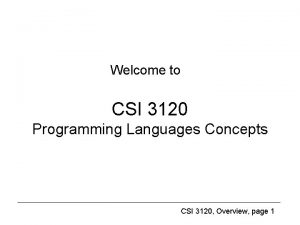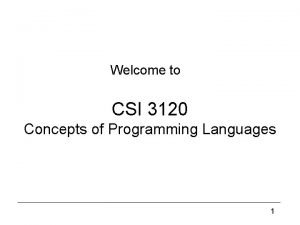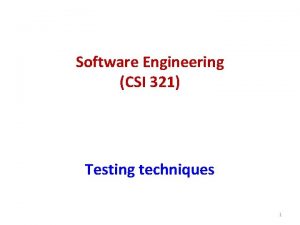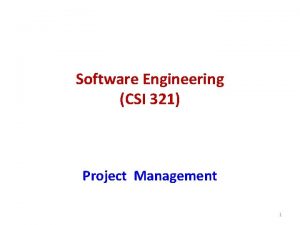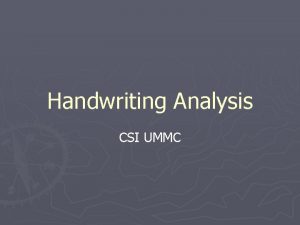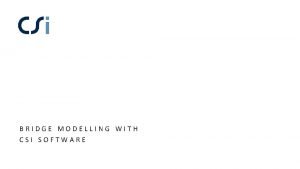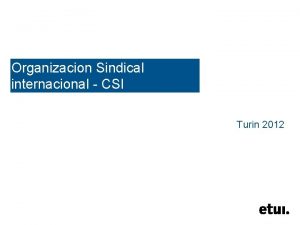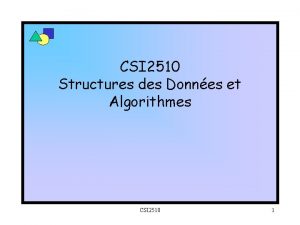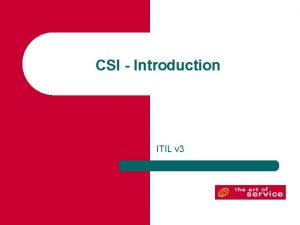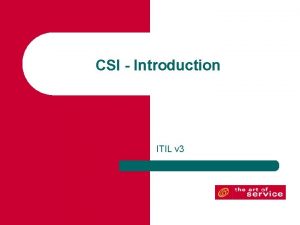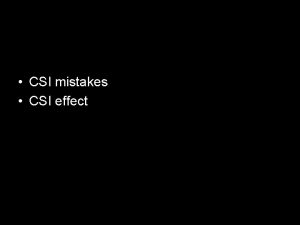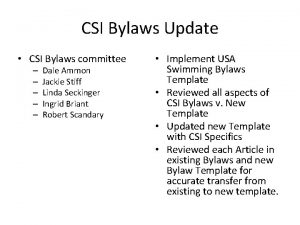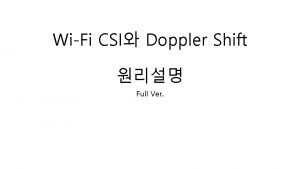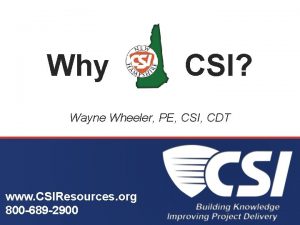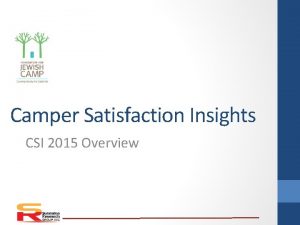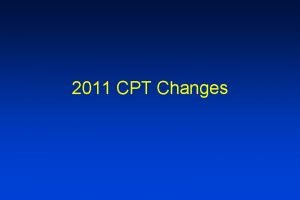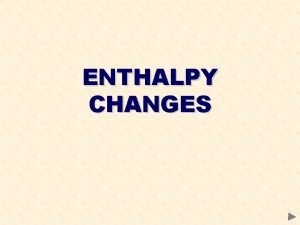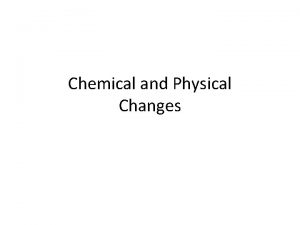CSI TRAINING Managing Changes to CSI with the



















































- Slides: 51

CSI TRAINING Managing Changes to CSI with the Mental Health Services Act (MHSA) and the Data Infrastructure Grant (DIG) July 1, 2006

What is CSI? n CSI is the Client and Service Information System. The State Department of Mental Health (DMH) requires all counties to collect and report CSI data on all Mental Health Services. n Timely and accurate reporting of this data to the Department of Mental Health is mandated. n CSI data will be used in conjunction with MHSA Data to evaluate the achievements of the County’s MHSA plan. CSI Training June 2006

Why Is The State Modifying CSI? n To further the Mental Health Services Act (MHSA) vision of transformation by collecting relevant data on all services. n To revise and update the existing Client Services Information (CSI) System. n To develop the capacity for data compliance to the federal Uniform Reporting System (URS); an objective of the federal Data Infrastructure Grant (DIG). CSI Training June 2006

Who Will Be Included? § MHSA requires that CSI data be collected for all services (MHSA or non-MHSA services), and for all consumers. CSI Training June 2006

How Will CSI Data Be Collected? § CSI Data will be collected from the INSYST System using the following Insyst screens: § § CSI Training June 2006 Client Registration Screen Episode Screen Service Entry Screen Periodic Screen

When Is CSI Data Reported? n n n Monthly – Data for new clients Monthly – A record for each service is reported, which includes expanded data Periodically – Selected data fields are reported: ¨ at entry ¨ annually ¨ at closing CSI Training June 2006

When Are CSI Changes Effective? July 1, 2006 CSI Training June 2006

Changes to CSI – Client Registration Form n n Changes have occurred and new data fields have been added. Client Registration screens have changed to accommodate the new data fields. REQUIRED CSI FIELDS n Date of Birth n Gender (Sex) n Social Security Number n Client Index Number (CIN) # n Education (Periodic data) n Language ¨ Primary Language # ¨ Preferred Language # LEGEND * Change in data field # New data field CSI Training June 2006

Changes to CSI Client Registration n Client Registration Form Required CSI Fields - Continued n n n n Ethnicity/Race * Hispanic Origin * Other Factors (Not to be used after July 1, 2006) Caregiver (Under 18/Over 18) # Birth Name Place of Birth Mother’s First Name (CSI Periodic Data must be entered on Client Registration and the Periodic screen) LEGEND * Change in data field # New data field CSI Training June 2006

NEW - Client Index Number (CIN) n Purpose: Identifies Medi-Cal or Healthy Families Plan recipients. The Client Index Number (CIN) must be reported if the client is a Medi-Cal recipient or Healthy Families Plan recipient. n Please note: Entry of a CIN in this field is an eligibility indicator for CSI only. Medi-Cal eligibility records still need to be entered on the Medicaid Eligibility screen for each client for each month of eligibility in order for services to be claimed to Medi-Cal. CSI Training June 2006

Changes to CSI – Client Registration n Education (Periodic data) Indicate the clients’ highest grade completed up to 20. This field is a periodic data field and must be reported at initial registration and updated annually on the periodic screen and client registration screen if the number changes. CSI Training June 2006

Changes to Language NEW - Primary Language Purpose: Identifies the primary language utilized by the client. NEW - Preferred Language Purpose: Identifies the language in which the client prefers to receive mental health services. “In what language would the client prefer to receive mental health services? ” CSI Training June 2006

Changes to Ethnicity & Hispanic Origin n Separate collection of Ethnicity and Hispanic Origin data- establishes consistency with and allows capacity to report to the Federal Uniform Reporting System (URS). n Updated Ethnicity Field – Now allows selection of up to five ethnicities. n New Hispanic Origin Field – distinct indicator for Hispanic Origin. n Use: Allows analysis of Ethnicity and Hispanic Origin data to ensure provision of culturally competent mental health services. Allows state and county data to be compared to federal census data. CSI Training June 2006

Changes to Ethnicity/Race n Change - Selection of up to five ethnicities. A White B Black C Native American E Chinese F Vietnamese G Laotian H Cambodian CSI Training June 2006 I Japanese J Filipino K Other Asian P Other Pacific Islander Q Korean R Samoan L Other Non-White M Unknown N Other Southeast Asian O Hmong S Asian Indian T Hawaiian Native U Guamanian W Mien

Changes to Hispanic Origin n New Hispanic Origin table is as follows: 1 - Not Hispanic 2 - Mexican/Mexican American 4 - Puerto Rican 5 - Other Latino G - Guatemalan N - Nicaraguan M - South American S - Salvadoran U - Unknown/Not Reported CSI Training June 2006

Caregiver n Purpose: Identifies the number of persons the client cares for / is responsible for at least 50% of the time: Number of children less than 18 years of age the client cares for / is responsible for at least 50% of the time. ¨ Number of dependent adults 18 years of age and above the client cares for / is responsible for at least 50% of the time. ¨ VALUES: 00 = None 01 through 98 = Number of children less than or over 18 years of age that the client cares for / is responsible for at least 50% of the time. 99 = Unknown / Not Reported CSI Training June 2006

Caregiver § This data element is needed to produce summary data on the number of clients who have dependent children under 18 years of age and/or dependent adults 18 years and older, how many dependents, and if the client is primary caregiver in order to identify patterns of need. This information will help reflect critical areas of the lives of California’s mental health clients. CSI Training June 2006

Changes to CSI Client Registration n CSI Training June 2006 CSI Periodic Data must be entered on Client Registration and Periodic Screens.

Changes to CSI – Episode Opening n Client Episode Opening Form ¨ Changes have occurred and new data fields have been added. ¨ Client Episode screens have changed to accommodate the new data fields. ¨ Required CSI Fields n Trauma # n Diagnosis # ¨ Axis I (P=Primary S=Secondary) § Axis I Additional DX ¨ Axis II (P=Primary S=Secondary) § Axis II Additional DX ¨ Axis III (Medical Condition Code or Medical Condition Diagnosis) ¨ Axis IV ¨ Axis V (Current/Past Year, Periodic data) § Axis V - Acceptable - 001 through 100 = Valid Axis-V / GAF Rating n Substance Abuse/Dependence Issue # n Substance Abuse Diagnosis # n Living Situation (Periodic data) n Employment Status (Periodic data) n Legal Consent (Periodic data) LEGEND CSI Training June 2006 * Change in data field # New data field

NEW – Episode Opening - Trauma Purpose: Identifies clients that have experienced traumatic events including experiences such as having witnessed violence, having been a victim of crime or violence, having lived through a natural disaster, having been a combatant or civilian in a war zone, having witnessed or having been a victim of a severe accident, or having been a victim of physical, emotional, or sexual abuse. Values Y = Yes N = No U = Unknown / Not reported CSI Training June 2006

NEW – Episode Opening - Trauma Question: What if some service records for a given client report a ‘yes’ in Trauma and others a ‘no’? How is that going to be interpreted? Answer: It is possible that some mental health providers working with a client may be aware of traumatic events in the client’s life and that others are not. If any provider in contact with the client is aware of trauma in the client’s history, they are encouraged to report it. It’s understood that some service records may reflect the client’s contact with trauma, while other records may not. CSI Training June 2006

Changes in Diagnosis code reporting includes: § Axis I (Primary or secondary) § Axis III – Additional Field and Codes - General Medical Condition Code or General Medical Diagnosis Code § Axis IV § Axis V current and past year CSI Training June 2006

Changes in Diagnosis n n Axis II Diagnosis Reporting Requirements Preferred - DSM-IV-TR Axis II code n Acceptable - ICD-9 -CM code n Acceptable - V 7109 and 7999, IF there is not a valid DSM-IV-TR Axis II or ICD-9 -CM code n CSI Training June 2006

Changes in Diagnosis Axis III – General Medical Condition Code or General Medical Diagnosis Code n General Medical Condition Summary Code Purpose: Identifies up to three General Medical Condition Summary Codes from a set list that most closely identify the client’s general medical condition(s), if any. n Do not report General Medical Condition Diagnosis. IF reporting General Medical Condition Summary Code(s). n Report up to three General Medical Condition Summary Code(s). CSI Training June 2006

Changes in Diagnosis Axis III – General Medical Condition Code or General Medical Diagnosis Code n General Medical Condition Summary Code CSI Training June 2006

Diagnosis - NOTE ¨ Use of V 71. 09 or 799. 9 is allowed if no other valid diagnosis is present on any of the Axis I or Axis II diagnosis fields on the episode screen. ¨ Use of V 71. 09 or 799. 9 in Axis II is acceptable only when coded with an “S” for Secondary. Incorrect input of these Diagnosis codes into INSYST will cause an error in CSI data and with the Medi-Cal claim which will require immediate correction. ¨ Not Acceptable - V 71. 09 – for Additional DX CSI Training June 2006

New Substance Abuse Reporting- After 07/01/06 • NEW – There are 2 New Substance Abuse / Dependence Fields: • Substance Abuse / Dependence Issue • Substance Abuse / Dependence Diagnosis CSI Training June 2006

New Substance Abuse Reporting- After 07/01/06 New - Substance Abuse / Dependence Diagnosis Purpose: Identifies whether or not the client has a substance / dependence issue. Services After 07/01/06: Report the client’s Substance Abuse / Dependence Issue. Reporting Requirements Y = Yes, the client has a substance abuse / dependence issue N = No, the client does not have a substance abuse / dependence issue U = Unknown / Not Reported • New - Substance Abuse / Dependence Diagnosis Purpose: Identifies the client’s substance abuse / dependence diagnosis, if any. Services On or After 07/01/06: Report the client’s Substance Abuse /Dependence Diagnosis. CSI Training June 2006

Changes to CSI – Episode Closing n Client Episode Closing Form ¨ Changes have occurred and new data fields have been added. ¨ Client Episode screens have changed to accommodate the new data fields. ¨ Required CSI Fields n Trauma # n Diagnosis # ¨ Axis I (P=Primary S=Secondary) § Axis I Additional DX ¨ Axis II (P=Primary S=Secondary) § Axis II Additional DX ¨ Axis III (Medical Condition Code or Medical Condition Diagnosis)) ¨ Axis IV ¨ Axis V (Current/Past Year, Periodic Data) § Axis V - Acceptable - 001 through 100 = Valid Axis-V / GAF Rating n Substance Abuse/Dependence Issue # n Substance Abuse Diagnosis # n Living Situation (Periodic Data) n Employment Status (Periodic Data) LEGEND * Change in data field # New data field CSI Training June 2006

Changes to CSI – Individual Staff Log n ¨ ¨ Changes have occurred and new data fields have been added. Multiple Service and Single Service Screens have changed to accommodate the new data fields. n Required CSI Fields ¨ Client number ¨ Procedure Code ¨ Duration ¨ Co-staff § Duration § Group Count ¨ Evidenced-Base Practices / Service Strategies # ¨ Service Location * LEGEND * Change in data field # New data field CSI Training June 2006

New – Evidence-Based Practices / Service Strategies The Department of Mental Health must report Evidence-Based Practices as identified by CMHS for federal reporting. The Service Strategies identified for reporting to CSI were selected based on the MHSA process and the CSS plans submitted by the counties. This provides the counties with the opportunity to describe the progressive strategies reflected in their programs/services, responding to the transformational vision of MHSA and the needs expressed by their consumers. CSI Training June 2006

New – Evidence-Based Practices / Service Strategies The Department of Mental Health is requesting reporting of Evidence-Based Practices and Service Strategies. At this time ACBHCS has identified Evidence-Based Practices and Service Strategies for relevant programs and is still under development. In the future ACBHCS will be informing the Community Based Organizations and County Clinics of Evidence. Based Practices and Service Strategy policies. n Do not enter data in the Evidence-Based Practices/Service Strategies field on service entry screens until further notice. CSI Training June 2006

Changes to CSI – Individual Staff Log n Individual Staff Log Required CSI Fields ¨ Service Location - Table of Values ¨ 1 = Office [formerly “Office (including phone)”] ¨ Definition: Services are provided in a location, other than a hospital, skilled nursing facility (SNF), correctional facility, public health clinic or facility supplying residential care, where the mental health professional routinely provides assessments, diagnosis, and mental health treatment on an ambulatory basis. ¨ 2= Field (unspecified) [formerly “Field (when location is away from the clinician’s usual place of business, except for Correctional Institution and Inpatient)”]. ¨ Definition: Services are provided in an unspecified location away from the clinician’s usual place of business, except for Correctional Institution, Inpatient, or Residential Care for adults or children. ¨ 3 = Phone ¨ Definition: Services are provided by telephone contact with the client, not involving video conferencing. ¨ 4 = Home ¨ Definition: Services are provided at a location, other than a hospital or other facility, where the client receives care in a private residence. ¨ 5 = School ¨ Definition: Services are provided in any facility that has the CSI Training June 2006 primary purpose of education. n

Changes to CSI – Individual Staff Log n Individual Staff Log Required CSI Fields ¨ Service Location - Table of Values - Continued ¨ 6 = Satellite Clinic ¨ Definition: Services are provided in a location, other than a hospital, skilled nursing facility (SNF), correctional facility, public health clinic or facility supplying residential care, where the mental health professional routinely provides assessments, diagnosis, and mental health treatment on an ambulatory basis. ¨ 8 = Correctional Facility (eg. , Jail, Prison, camp/ranch, etc. ) [Formerly “Correctional Institution”] ¨ Definition: Services are provided in a correctional facility, including adult or juvenile detention facilities. ¨ 9 = Inpatient (e. g. , Hospital, Psychiatric Health Facility (PHF), Skilled Nursing Facility (SNF), Institute for Mental Disease (IMD), Mental Health Rehabilitation Center (MHRC). ¨ Definition: Services are provided in a facility which primarily provides diagnostic, therapeutic, and rehabilitative services. Includes hospitals, psychiatric health facilities (PHF), skilled nursing facilities (SNF), Institutes for Mental Disease (IMDs), Mental Health Rehabilitation Centers (MHRC). ¨ 10 = Homeless / Emergency Shelter ¨ Definition: Services are provided in a facility specifically designed to provide shelter to the general homeless population. CSI Training June 2006 n

Changes to CSI – Individual Staff Log n Required CSI Fields ¨ Service Location - Table of Values- Continued ¨ ¨ ¨ ¨ CSI Training June 2006 11 = Faith-based (e. g. , church, temple, etc. ) Definition: Services are provided in a location owned or leased by a faith group, with partial or full involvement of the faith group. 12 = Health Care / Primary Care Definition: Services are provided by the consumer’s primary care or general health care provider, or in the clinic or facility of the health care provider, including emergency room and public health clinics 13 = Age-Specific Community Center Definition: Services are provided in a location owned or leased by an age-specific community center, such as a senior’s center, a teen drop -in center, etc. 14 = Client’s Job Site Definition: Services are provided at the client’s site of employment.

Changes to CSI – Individual Staff Log n Required CSI Fields ¨ Service Location - Table of Values-Continued ¨ 15 = Residential Care – Adults ¨ Definition: Services are provided in a location supplying 24 -hr non-medical care for adults, not including inpatient hospital, psychiatric health facilities (PHFs), skilled nursing facilities (SNFs), Institutes for Mental Disease (IMDs), Mental Health Rehabilitation Centers (MHRCs), or homeless/emergency shelters. Includes assisted living facilities for adults such as group homes. ¨ 16 = Mobile Service ¨ Definition: This definition is consistent with the concept of a Mobile Clinic. Mobile clinics provide services to individuals in rural or outlying areas where services are otherwise inaccessible. The concept of mobile services is in contrast to services provided at other community locations (see other listed service settings) that are reached by vehicle. ¨ 17 = Non-Traditional service location (e. g. , park bench, on street, under bridge, abandoned building) ¨ Definition: Services are provided in the community, but not in a community center, school, faith-based location, homeless/emergency shelter, health-care center, or the client’s job site. Examples include park bench, on the street under a bridge, in an abandoned building, etc. CSI Training June 2006

Changes to CSI – Individual Staff Log n Required CSI Fields ¨ Service Location - Table of Values-Continued ¨ ¨ ¨ ¨ CSI Training June 2006 18 = Other Community location Definition: Services are provided in the community, but not in a homeless/emergency shelter, a faith-based location, home, the client’s job site, a non-traditional service location, an age-specific community center, or school. Includes community centers that are not age-specific, nonresidential substance-abuse treatment centers etc. 19 = Residential Care – Children Definition: Services are provided in a location supplying 24 -hr nonmedical care for children, other than inpatient hospital, or psychiatric health facilities (PHFs). Includes Community Treatment Facilities (CTFs) and family foster homes. Definition of Community Treatment Facility (CTF): Any residential facility that provides mental health treatment services to children in a group setting which has the capacity to provide secure containment. 20 = Telehealth Definition: Also known as “Telemedicine. ” Services are provided so that the clinician and client are in two different locations but can see each other via visual equipment (e. g. , video camera, web camera). 21 = Unknown / Not Reported

Periodic Data Reporting DMH has determined that certain Client data is periodic in nature and needs to be reviewed and reported at periodic intervals. CSI Training June 2006 • Education • Other Factors (Not to be used after July 1, 2006) • Employment Status • Axis V (Not to be used after July 1, 2006) • Legal Consent • Living Arrangement • Caregiver

When to Report Periodic Data New Clients – All new clients must report “Periodic” data to DMH (Department of Mental Health). Complete periodic input after completing the Client Registration Screen. Annually – All open clients must report “Periodic” data to DMH. At Closing – When you close out a client “Periodic” data must be reported to DMH. Note: Overdue and missing Periodic data will be monitored. CSI Training June 2006

Changes to CSI Periodic n NOTE: ¨ ¨ CSI Training June 2006 Other Factors (Not To Be Used After July 1, 2006) Axis V (Not To Be Used After July 1, 2006)

Periodic Data Reporting • Enter Periodic data on the Periodic Screen located in Insyst under the Client Maintenance Menu. Select the CSI Periodic Maintenance Screen. • Axis V and Other Factors fields are to be left blank; these will be removed from the Periodic Screen. CSI Periodic Data Maintenance Client Number: Periodic Date Legal Other Last CSI Completed Axis 5 Consent Factors Reporting Date +—————————————————————————————————————+ | - - - - | | - - - - | +—————————————————— CSI Training June 2006

Periodic Data Reporting If there is no data visible on this screen, Periodic data must be input. • If data exists, check the “Last CSI Reporting Date” field for a date. If the date is within 30 days of the annual due date, review and update this screen as appropriate. • If the Annual Periodic Date has expired, update and complete the Periodic Screen. • CSI Periodic Data Maintenance Client Number: Periodic Date Legal Other Last CSI Completed Axis 5 Consent Factors Reporting Date +————————————————————+ | 13 -Jul-2001 50 G None 31 -Jul-2001 | | - - - - | | - - - - | +————————————————————+ CSI Training June 2006

Periodic Data Reporting Enter a “U” to the left of the “Periodic Date Completed” field. • CSI Periodic Data Maintenance Client Number: Periodic Date Legal Other Last CSI Completed Axis 5 Consent Factors Reporting Date +——————————————————————+ | 13 -Jul-2001 50 G None 31 -Jul-2001 | | - - - - | | - - - - | +——————————————————————+ CSI Training June 2006

Periodic Data Reporting • Data will default from the Periodic Record selected • Review and Change data • Tab to “Form OK • Enter “Y” CSI Periodic Data Update Client Number: +——————————————————————+ | | | Periodic date completed: 7 /13/2001 Employment status: 8 | | Education: 3 Axis 5: 50 | | Other Factors: 0 Legal Consent: G | | Living Situation: 5 | | CSI Reported date: 31 -JUL-2001 | | | +——————————————————————+ Form Ok Y/N: CSI Training June 2006 Confidential Information

Periodic Data Report PSP 613 - Missing CSI Initial or Annual Periodic Data Report Description: §This report lists client name, client number, opening date, and last service date by provider for clients with missing or expiring CSI periodic data by reporting unit. §The report will be used by the Providers to determine and input overdue Periodic Data into Insyst. §This report will be run on the first Monday of every month for clients with missing Periodic data or Periodic data that will expire in the next 30 days. §PSP 613 Report - Missing CSI Initial or Annual Periodic Data Report Description will be sent to your printer and will be available Tuesday morning. CSI Training June 2006

Periodic Data Report PSP 613 - Missing CSI Initial or Annual Periodic Data Report Description: § The report will be monitored by DBH IS staff for completeness and compliance of submission of records for overdue Periodic Records. § If after review, it is determined that the Provider is non-compliant with submission of Periodic Records, the Provider will be notified of non-compliance and corrective action will be requested. § DBH IS staff will also notify Provider Relations for intervention assistance. § Upon a second notice to the Provider of non-compliance, DBH Operations Management will be notified for further instructions and intervention. CSI Training June 2006

Monitoring CSI Compliance n Monitoring Reports will be used to identify possible problem areas in CSI data collection. n Analysis of findings will be performed to monitor data validity and integrity. Organizations will be notified of areas where improvement is indicated. n ASG will be notified and available to offer assistance in remediation of problem areas. n ASG Operations Management will be notified for further instructions and intervention if needed. CSI Training June 2006

Timeline for Transitioning to New CSI Requirements n Make every effort to finish June Input before July 5, 2006. n The In. Syst screens will change to reflect the new requirements on Sunday, July 2, 2006. n Do not enter July input until after July 5, 2006. CSI Training June 2006

ANOTHER CRITICAL DATA COLLECTION ISSUE n DBH expects that a complete and accurate address be entered for every client. It is very important that we know where our clients live. n The changes in Medi-Cal claim formatting/coding mandated by HIPAA, require an address for each client, including a valid zip code. In. Syst will edit your zip code entry to ensure that it is valid. n For homeless clients, enter “homeless” in the Street field, enter the City where the client usually sleeps, and a valid zip code. CSI Training June 2006

Support and Follow-Up n If you wish to receive additional training for CSI input, please contact the ISD Helpdesk@ (909) 884 -4884. CSI Training June 2006

For Provider Support - Contact Call or e-mail – System Support @ 909 -884 -4884 or e-mail: ISDHELPDESK@isd. sbcounty. gov DBH website: www. sbcounty. gov/contracts CSI Training June 2006
 Changes in latitudes, changes in attitudes meaning
Changes in latitudes, changes in attitudes meaning Physical reaction
Physical reaction Hình ảnh bộ gõ cơ thể búng tay
Hình ảnh bộ gõ cơ thể búng tay Frameset trong html5
Frameset trong html5 Bổ thể
Bổ thể Tỉ lệ cơ thể trẻ em
Tỉ lệ cơ thể trẻ em Chó sói
Chó sói Tư thế worm breton là gì
Tư thế worm breton là gì Bài hát chúa yêu trần thế alleluia
Bài hát chúa yêu trần thế alleluia Các môn thể thao bắt đầu bằng tiếng bóng
Các môn thể thao bắt đầu bằng tiếng bóng Thế nào là hệ số cao nhất
Thế nào là hệ số cao nhất Các châu lục và đại dương trên thế giới
Các châu lục và đại dương trên thế giới Công thức tính thế năng
Công thức tính thế năng Trời xanh đây là của chúng ta thể thơ
Trời xanh đây là của chúng ta thể thơ Cách giải mật thư tọa độ
Cách giải mật thư tọa độ Làm thế nào để 102-1=99
Làm thế nào để 102-1=99 Phản ứng thế ankan
Phản ứng thế ankan Các châu lục và đại dương trên thế giới
Các châu lục và đại dương trên thế giới Thơ thất ngôn tứ tuyệt đường luật
Thơ thất ngôn tứ tuyệt đường luật Quá trình desamine hóa có thể tạo ra
Quá trình desamine hóa có thể tạo ra Một số thể thơ truyền thống
Một số thể thơ truyền thống Cái miệng nó xinh thế chỉ nói điều hay thôi
Cái miệng nó xinh thế chỉ nói điều hay thôi Vẽ hình chiếu vuông góc của vật thể sau
Vẽ hình chiếu vuông góc của vật thể sau Nguyên nhân của sự mỏi cơ sinh 8
Nguyên nhân của sự mỏi cơ sinh 8 đặc điểm cơ thể của người tối cổ
đặc điểm cơ thể của người tối cổ Thế nào là giọng cùng tên? *
Thế nào là giọng cùng tên? * Vẽ hình chiếu đứng bằng cạnh của vật thể
Vẽ hình chiếu đứng bằng cạnh của vật thể Vẽ hình chiếu vuông góc của vật thể sau
Vẽ hình chiếu vuông góc của vật thể sau Thẻ vin
Thẻ vin đại từ thay thế
đại từ thay thế điện thế nghỉ
điện thế nghỉ Tư thế ngồi viết
Tư thế ngồi viết Diễn thế sinh thái là
Diễn thế sinh thái là Các loại đột biến cấu trúc nhiễm sắc thể
Các loại đột biến cấu trúc nhiễm sắc thể Số nguyên tố là
Số nguyên tố là Tư thế ngồi viết
Tư thế ngồi viết Lời thề hippocrates
Lời thề hippocrates Thiếu nhi thế giới liên hoan
Thiếu nhi thế giới liên hoan ưu thế lai là gì
ưu thế lai là gì Hổ đẻ mỗi lứa mấy con
Hổ đẻ mỗi lứa mấy con Sự nuôi và dạy con của hươu
Sự nuôi và dạy con của hươu Hệ hô hấp
Hệ hô hấp Từ ngữ thể hiện lòng nhân hậu
Từ ngữ thể hiện lòng nhân hậu Thế nào là mạng điện lắp đặt kiểu nổi
Thế nào là mạng điện lắp đặt kiểu nổi Training is expensive without training it is more expensive
Training is expensive without training it is more expensive Metode of the job training
Metode of the job training Aggression replacement training facilitator training
Aggression replacement training facilitator training Csi 3120
Csi 3120 Csi3120
Csi3120 Csi 321
Csi 321 Csi in project management
Csi in project management Two people can have identical handwriting.
Two people can have identical handwriting.















































